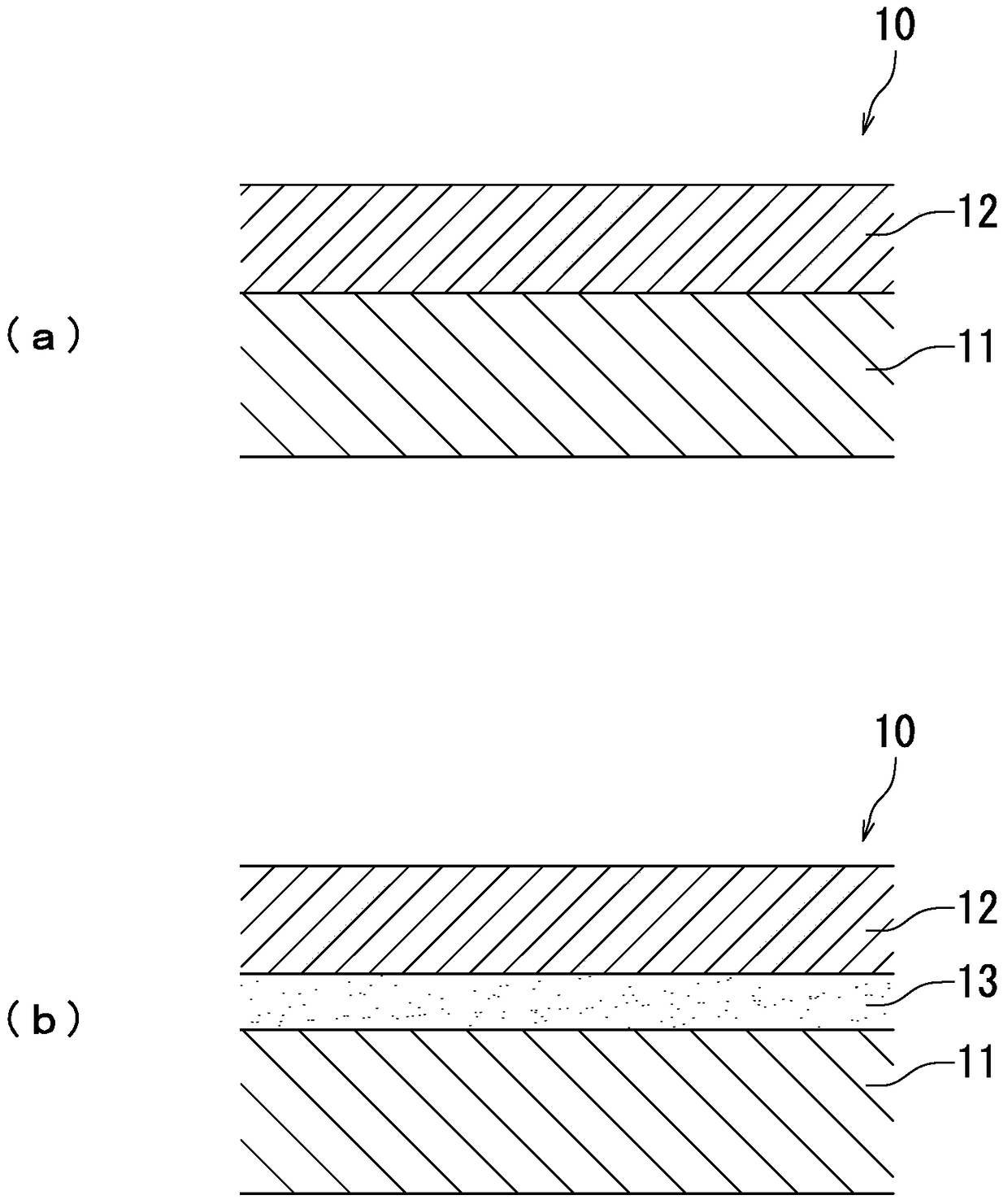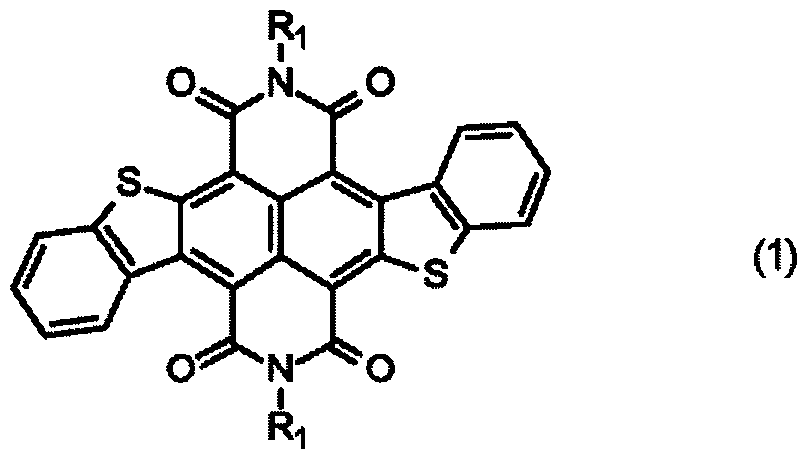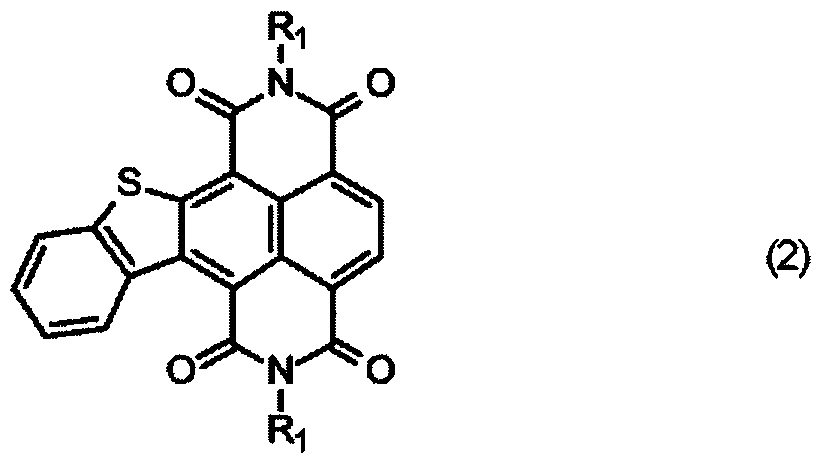Electrophotographic photoreceptor
A technology of electrophotography and photoreceptor, which is applied in the fields of optics, electrography, instruments, etc., can solve the problems such as difficulty in developing the sensitivity characteristics, and achieve the effect of excellent sensitivity characteristics
- Summary
- Abstract
- Description
- Claims
- Application Information
AI Technical Summary
Problems solved by technology
Method used
Image
Examples
Synthetic example 1
[0080] The naphthalimide derivative represented by the following general formula (1-2) was synthesized according to the following reaction equation 3.
[0081] [Electron Transport Agent (ETM-1)]
[0082] 【Chemical formula 8】
[0083]
[0084] [Reaction equation 3]
[0085] 【Chemical formula 9】
[0086]
[0087] In reaction equation 3(a-2), 0.875 g (1 mmol) of compound (A-12), 0.812 g (4 mmol) of 2-bromoanisole sulfide, 58 mg (0.05 mmol) of tetrakis(triphenylphosphine) palladium and iodine A toluene solution of 19 mg (0.1 mmol) of cuprous oxide was refluxed and stirred for 10 hours under a nitrogen atmosphere at a temperature of 110° C. to obtain a reaction solution.
[0088] The toluene solvent in the resulting reaction solution was distilled off and purified by column chromatography to obtain 0.6 g of compound (A-22) (yield: 85%).
[0089] In the reaction equation 3(b-2), a solution of 0.708g (1mmol) of compound (A-22), 10ml of acetic acid and 10ml of chloroform was cooled with ice, and...
Synthetic example 2
[0094] The naphthalimide derivative represented by the following general formula (1-3) is synthesized according to the following reaction equation 4.
[0095] [Electron Transport Agent (ETM-2)]
[0096] 【Chemical formula 10】
[0097]
[0098] [Reaction equation 4]
[0099] 【Chemical formula 11】
[0100]
[0101] In reaction equation 4(a-3), 0.78 g (1 mmol) of compound (A-13), 0.81 g (4 mmol) of 2-bromoanisole sulfide, 58 mg (0.05 mmol) of tetrakis(triphenylphosphine) palladium and iodine A toluene solution of 19 mg (0.1 mmol) of cuprous oxide was refluxed and stirred at a temperature of 110° C. for 10 hours under a nitrogen atmosphere to obtain a reaction solution.
[0102] The toluene solvent in the resulting reaction solution was distilled off and purified by column chromatography to obtain 0.49 g of compound (A-23) (yield: 80%).
[0103] Next, in reaction equation 4 (b-3), a solution of 0.61 g (1 mmol) of compound (A-23), 10 ml of acetic acid and 10 ml of chloroform is cooled with ice...
Synthetic example 3
[0107] The naphthalimide derivative represented by the following general formula (1-4) was synthesized according to the following reaction equation 5.
[0108] [Electron Transport Agent (ETM-3)]
[0109] 【Chemical formula 12】
[0110]
[0111] [Reaction equation 5]
[0112] 【Chemical formula 13】
[0113]
[0114] In reaction equation 5(a-4), 1.17 g (1 mmol) of compound (A-14), 1.62 g (4 mmol) of 2-bromoanisole sulfide, 58 mg (0.05 mmol) of tetrakis(triphenylphosphine) palladium and iodine A toluene solution of 19 mg (0.1 mmol) of cuprous oxide was refluxed and stirred at a temperature of 110° C. for 10 hours under a nitrogen atmosphere to obtain a reaction solution.
[0115] The toluene solvent of the obtained reaction solution was distilled off and purified by column chromatography to obtain 0.66 g of compound (A-24) (yield: 80%).
[0116] Next, in reaction equation 5(b-4), a solution of 0.83 g of compound (A-24), 10 ml of acetic acid and 10 ml of chloroform was cooled with ice, and the...
PUM
 Login to View More
Login to View More Abstract
Description
Claims
Application Information
 Login to View More
Login to View More - R&D
- Intellectual Property
- Life Sciences
- Materials
- Tech Scout
- Unparalleled Data Quality
- Higher Quality Content
- 60% Fewer Hallucinations
Browse by: Latest US Patents, China's latest patents, Technical Efficacy Thesaurus, Application Domain, Technology Topic, Popular Technical Reports.
© 2025 PatSnap. All rights reserved.Legal|Privacy policy|Modern Slavery Act Transparency Statement|Sitemap|About US| Contact US: help@patsnap.com



